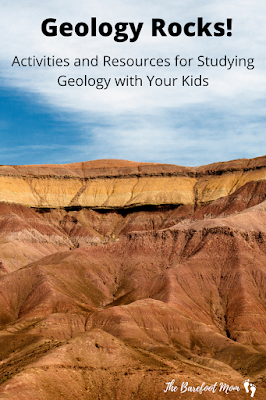Geology is a favorite subject in my household. There's so many fascinating topics to explore like volcanoes, earthquakes, dinosaurs, fossils, the rock cycle, and more. My kids are also avid rock and fossil hunters and we love learning all we can about our finds. Our rock hounding adventures and our love for all things geologic has been the inspiration for quite a few of my posts over the last several years. I thought I would share links to all my geology related posts in one spot where they are easy to access.
What is Geology? And Why Study it?
Geology is the study of the Earth's physical structure, its processes, and its 4.5 billion year history. It includes things like the study of rocks and minerals, volcanology, plate tectonics, earthquakes, Paleontology, erosion, decomposition, and oceanography.
Geology plays a pivotal role in many different career paths and there is a growing need for geoscientists. Geoscientists are working on solving some of the most critical problems of our time such as sustaining important resources like water, minerals, and energy; changes in our environment and climate, and predicting or preventing natural hazards like earthquakes, volcanic eruptions, and landslides.
Geology Links
Printable Rock and Mineral Journal
Journal for recording rock and mineral finds and for recording identifying observations and properties. Includes information about identifying minerals, a flow chart for determining hardness, a flow chart for determining luster, 2 pages with properties of common minerals, and pages for journaling.
Learning About the Mesozoic Era- The Age of the Dinosaurs
Activities and resources for learning about the animals of the Mesozoic Era
Instructions for making mock fossils with salt dough and plastic dinosaurs
Learning About Geologic History- The Paleozoic Era
Activities and resources for learning about the animals of the Paleozoic Era
Learning About Geologic History- The Cenozoic Era
Activities and resources for learning about the animals and geology of the Cenozoic Era
Information about the different types of fossils plus activities and links to resources
Tips and ideas for hunting and collecting rocks with kids
Why Don't Rivers Run Straight? A Hands on Demonstration
A really fun hands on activity that demonstrates why rivers twist and turn
Composting with Kids- A Fun Way to Learn About Soil
Lots of information about how to start a backyard compost bin plus links to resources for teaching your kids about decomposition and the nutrient cycle.
Make Your Own Mineral Identification Kit
Learn how to identify different types of minerals and put together your own simple mineral ID kit
How Metamorphic Rock is Made: A Simple Hands on Demonstration
A simple hands on activity that demonstrates how metamorphic rocks are formed
A simple way to add a little geography study to your homeschool week is by taking hikes or nature walks. Pay special attention to any interesting geographical features that you come across.
What are some of your favorite ways to study geology?
Follow me on:














Comments
Post a Comment